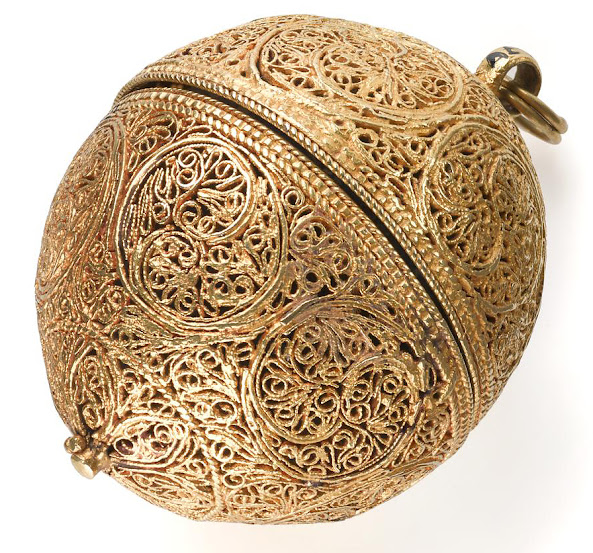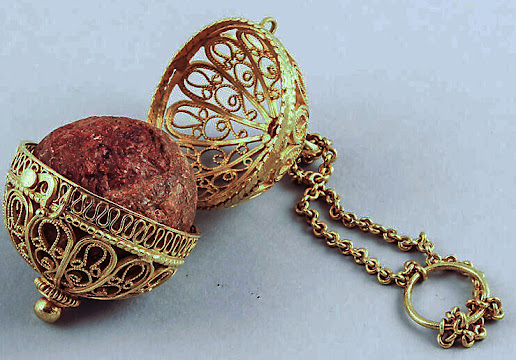17th/ 18th Century Gold Filigree Casket.
Brodick Castle Collection.
National Trust of Scotland.
Post In preparation updated 25 May 2023.
Currently the size is unavailable.
The confirmation of the filigree work suggest that it is perhaps Indian, but a serious study of techniques of items with a definite Indian provenance needs to be undertaken in order to confirm any attribution.
The use of the multiple very small and very fine comma shaped twisted wire elements within a frame of rectangular section wire, suggests perhaps Cuttack, Orissa, India but comparisons should be made with the Indian?round and Chinese? octagonal boxes pictured below.
Overall sizes : 33 mm, 25 mm,
Diameter: Diameter: 3 centimetres.
Height: Height: 4.50 centimetres.
Curator's comments from the BM website:
Text from catalogue of the Hull Grundy Gift (Gere et al
1984) no 400:
The filigree work is extremely fine. For a documentary example of sixteenth-century filigree work, see the gold casing of the bezoar pendant with the arms of the Duke of Alva (1508-83) (pictured below) now in the Kunsthistorisches Museum, Vienna (inv. no.998), and recorded in the Imperial Treasury in Vienna since 1750 (see Somers Cocks 1980, no.21). In her catalogue entry, Anna Somers Cocks points out that filigree was popular in many areas of Europe, including Spain, Italy and the German towns, and is notoriously difficult to date and to attribute to a country of origin. She concludes that although the pendant belonged to Alva, the Spanish envoy to the Netherlands, it was not necessarily made in Spain; she refers also to two bezoars set in gold filigree owned by Marie-Louise d'Orleans, as well as 'a little gold wire basket of fine work' owned by Kurfurstin Anna of Saxony, at her death in 1585 (see van Watzdorf 1934, p.62).
The Kunsthistorisches Museum also contains a gold
filigree casket of comparable delicacy, recorded in the Imperial Treasury since
1765 and described as possibly second half of the seventeenth century (see Kris
1932b, no.122. The Alva bezoar pendant is no. 31).
Information supplementary to Hull Grundy catalogue:
The use of a screw thread is more characteristic of European
than Indian work, but the delicacy and the particular patterns of the filigree
has much in common with Indian work from Portuguese Goa of the 17th century,
see Helmut Trnek and Nuno Vassallo e Silva (eds), 'Exotica. The Portuguese
Discoveries and the Renaissance Kunstkammer', exhibition catalogue, Calouste
Gulbenkian Museum, Lisbon, 2002, p. 154, cat. no. 49: a mounted bezoar stone in
the Kunsthistorishes Museum, Vienna, dated to the late 17th century. The
filigree pattern is very close indeed with the same use of scrolls alternating
with simple loops to form a fan motif within the scroll-shaped frame. The Alva
bezoar pendant is also included here as cat.no. 47, p. 151, catalogued as Goa,
last quarter of the 16th century. (J. Rudoe, 22.5.2013).
-----------
The BM curators note is somewhat disingenuous - a brief scrutiny of the manufacturing techniques suggest that the Duke of Alba Bezoar is not related to the BM pomander
Height 3.0 cm × diameter 2.4 cms.
Interesting monogram/cypher.
These very fine vases with diamond and turquoise collars,
are 10cm high, 6.5cm in diameter.
The 1690 Devonshire Schedule which itemised an immense bequest from Elizabeth, Countess of Devonshire (1619-1689), to her daughter Anne, Countess of Exeter (1649-1703), records under the heading: ‘gold things’…..’Two Gold Jarrs philligrin with Covers sett round the Necks with Turquoise and Diamonds.’
.............................
For comparison
Pair vases in the Hermitage, St Petersburg Collection.
_______________________
Size approx. 11.5 x 13 x 43cms.
Approx. 4.5 x 9.5 x 6 cms.
_____________________
The Broddick Bezoar Stone in Gold Filigree Case.
Believed to be part of Brodick’s William Beckford Collection which was inherited by Susan
Beckford, wife of the 10th Duke, upon her father’s death.
I have contacted Broddick and await further information.


















.jpg)
.jpg)
.jpg)






.jpg)














No comments:
Post a Comment